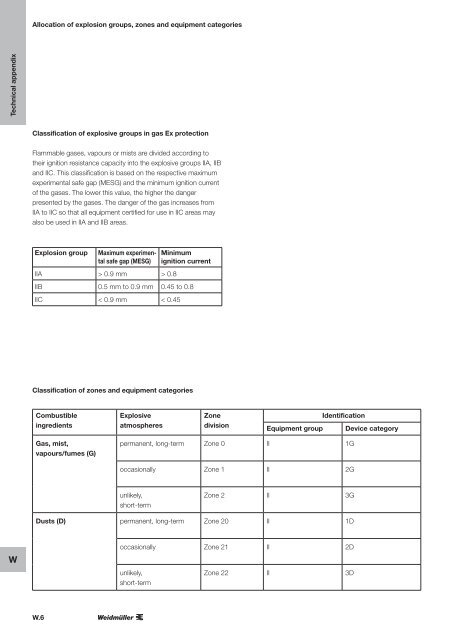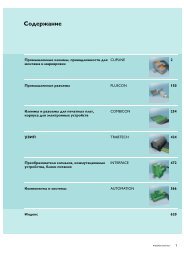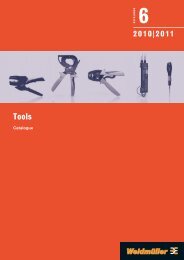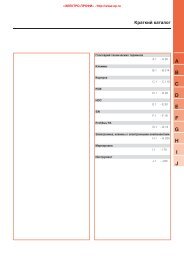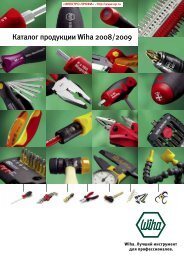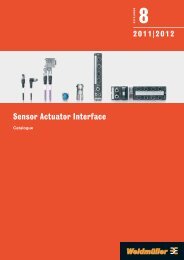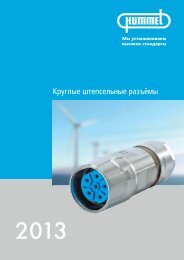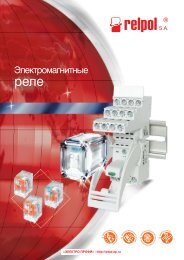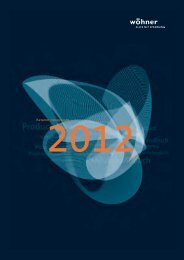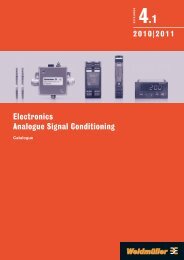- Page 1 and 2:
C A T A L O G U E 5 2011|2012 Enclo
- Page 3 and 4:
C A T A L O G U E 5 Enclosures and
- Page 5 and 6:
Product overview EMC - cable glands
- Page 7 and 8:
Enclosures and Cable Glands Content
- Page 9 and 10:
Harmonisation - the key to market s
- Page 11 and 12:
Application specific solutions - yo
- Page 13 and 14:
Contents Enclosures Enclosures Encl
- Page 15 and 16:
Introduction Plastic enclosures Enc
- Page 17 and 18:
Introduction Enclosures Klippon ®
- Page 19 and 20:
Introduction Enclosures TBF Page B.
- Page 21 and 22:
Enclosures B B.9
- Page 23 and 24:
Klippon ® TB MH - Multi Hinge Encl
- Page 25 and 26:
Klippon ® TB MH - Multi Hinge Klip
- Page 27 and 28:
Klippon ® TB MH - Multi Hinge Klip
- Page 29 and 30:
Klippon ® TB MH - Multi Hinge Klip
- Page 31 and 32:
Klippon ® TB MH - Multi Hinge Klip
- Page 33 and 34:
Klippon ® TB MH - Multi Hinge Klip
- Page 35 and 36:
Klippon ® TB MH - Multi Hinge Klip
- Page 37 and 38:
Klippon ® TB MH - Multi Hinge Klip
- Page 39 and 40:
Klippon ® TB MH - Multi Hinge Klip
- Page 41 and 42:
Klippon ® TB MH - Multi Hinge Klip
- Page 43 and 44:
Klippon ® TB MH - Multi Hinge Klip
- Page 45 and 46:
Klippon ® TB MH - Multi Hinge Klip
- Page 47 and 48:
Enclosures B B.35
- Page 49 and 50:
Klippon ® TB QL - Quarter Lock Enc
- Page 51 and 52:
Klippon ® TB QL - Quarter Lock Kli
- Page 53 and 54:
Klippon ® TB QL - Quarter Lock Kli
- Page 55 and 56:
Klippon ® TB QL - Quarter Lock Kli
- Page 57 and 58:
Klippon ® TB QL - Quarter Lock Kli
- Page 59 and 60:
Klippon ® TB QL - Quarter Lock Kli
- Page 61 and 62:
Klippon ® TB QL - Quarter Lock Kli
- Page 63 and 64:
Klippon ® TB QL - Quarter Lock Kli
- Page 65 and 66:
Klippon ® TB QL - Quarter Lock Kli
- Page 67 and 68:
Klippon ® TB QL - Quarter Lock Kli
- Page 69 and 70:
Klippon ® TB QL - Quarter Lock Kli
- Page 71 and 72:
Klippon ® TB QL - Quarter Lock Kli
- Page 73 and 74:
Klippon ® TB - System accessories
- Page 75 and 76:
Klippon ® STB - Sheet steel enclos
- Page 77 and 78:
Klippon ® STB - Sheet steel enclos
- Page 79 and 80:
Klippon ® STB - Sheet steel enclos
- Page 81 and 82:
Klippon ® STB - Sheet steel enclos
- Page 83 and 84:
Klippon ® STB - Sheet steel enclos
- Page 85 and 86:
Klippon ® K - Aluminium enclosures
- Page 87 and 88:
Klippon ® K - Aluminium enclosures
- Page 89 and 90:
Klippon ® K - Aluminium enclosures
- Page 91 and 92:
Klippon ® K - Aluminium enclosures
- Page 93 and 94:
Klippon ® K - Aluminium enclosures
- Page 95 and 96:
Klippon ® K - Aluminium enclosures
- Page 97 and 98:
Klippon ® K - Aluminium enclosures
- Page 99 and 100:
Klippon ® K - Aluminium enclosures
- Page 101 and 102:
Klippon ® K - Aluminium enclosures
- Page 103 and 104:
Klippon ® K - Aluminium enclosures
- Page 105 and 106:
Enclosures B B.93
- Page 107 and 108:
Klippon ® POK - Polyester enclosur
- Page 109 and 110:
Klippon ® POK - Polyester enclosur
- Page 111 and 112:
Klippon ® POK - Polyester enclosur
- Page 113 and 114:
Klippon ® POK - Polyester enclosur
- Page 115 and 116:
Klippon ® POK - Polyester enclosur
- Page 117 and 118:
Klippon ® POK - Polyester enclosur
- Page 119 and 120:
Klippon ® POK - Polyester enclosur
- Page 121 and 122:
Klippon ® POK - Polyester enclosur
- Page 123 and 124:
Klippon ® POK - Polyester enclosur
- Page 125 and 126:
Enclosures B B.113
- Page 127 and 128:
TBF - Polyester enclosures Enclosur
- Page 129 and 130:
TBF - Polyester enclosures TBF 30/3
- Page 131 and 132:
TBF - Polyester enclosures TBF 60/3
- Page 133 and 134:
Enclosures B B.121
- Page 135 and 136:
MPC - Polycarbonate enclosures Encl
- Page 137 and 138:
MPC - Polycarbonate enclosures MPC
- Page 139 and 140:
MPC - Polycarbonate enclosures MPC
- Page 141 and 142:
Enclosures B B.129
- Page 143 and 144:
Enclosures B B.131
- Page 145 and 146:
FPC - Polycarbonate enclosures FPC
- Page 147 and 148:
Contents Cable entries Cable entrie
- Page 149 and 150:
Introduction Cable entries You shou
- Page 151 and 152:
Introduction Cable entries Adaptor
- Page 153 and 154:
Standard cable glands - Plastic Cab
- Page 155 and 156:
Standard cable glands - Brass Cable
- Page 157 and 158:
Standard cable glands - Brass Cable
- Page 159 and 160:
Standard cable glands - Brass Cable
- Page 161 and 162:
EMC cable glands Cable glands - Bra
- Page 163 and 164:
Standard cable gland - Stainless st
- Page 165 and 166:
Cable glands for Ex applications -
- Page 167 and 168:
Cable glands for Ex applications -
- Page 169 and 170:
Cable glands for Ex applications -
- Page 171 and 172:
Cable glands for Ex applications -
- Page 173 and 174:
Cable glands for Ex applications -
- Page 175 and 176:
Cable glands for Ex applications -
- Page 177 and 178:
Cable glands for Ex applications -
- Page 179 and 180:
Cable glands for Ex applications -
- Page 181 and 182:
Cable glands for Ex applications -
- Page 183 and 184:
Accessories - Lock nuts Lock nuts -
- Page 185 and 186:
Accessories - Lock nuts Lock nuts -
- Page 187 and 188:
Accessories - Lock nuts Lock nuts -
- Page 189 and 190:
Accessories - Flat IP washer Flat I
- Page 191 and 192:
Accessories - Flat IP washer Flat I
- Page 193 and 194:
Accessories - Earth tags Accessorie
- Page 195 and 196:
Accessories - Shrouds Accessories -
- Page 197 and 198:
Sealing plugs Sealing plugs - Plast
- Page 199 and 200:
Sealing plugs Sealing plugs - Plast
- Page 201 and 202:
Sealing plugs Sealing plugs - Brass
- Page 203 and 204:
Sealing plugs Sealing plugs - Plast
- Page 205 and 206:
Adaptors Adaptors with metric male
- Page 207 and 208:
Compensating elements Compensation
- Page 209 and 210:
Compensating elements Compensation
- Page 211 and 212:
Contents Cable entry system Cable e
- Page 213 and 214:
Cable grommets HDC KT ... Cable gro
- Page 215 and 216:
Cable entry strips and panels HDC K
- Page 217 and 218:
Cable entry strips and panels HDC K
- Page 219 and 220:
Strain-relief strips Strain-relief
- Page 221 and 222:
Contents Distribution boxes Distrib
- Page 223 and 224:
Standardised distribution boxes as
- Page 225 and 226:
Standardised distribution boxes - p
- Page 227 and 228:
Standardised distribution boxes - p
- Page 229 and 230:
Klippon ® - Aluminium enclosures K
- Page 231 and 232:
Klippon ® - Aluminium enclosures K
- Page 233 and 234:
Klippon ® - Aluminium enclosures K
- Page 235 and 236:
Klippon ® - Aluminium enclosures K
- Page 237 and 238:
Klippon ® - Aluminium enclosures K
- Page 239 and 240:
Klippon ® - Polyester enclosures K
- Page 241 and 242:
Klippon ® - Polyester enclosures K
- Page 243 and 244:
Klippon ® - Polyester enclosures K
- Page 245 and 246:
Contents FieldPower ® FieldPower
- Page 247 and 248: for outer Tu 25 °C 25.5 W for oute
- Page 249 and 250: Building automation FieldPower ® C
- Page 251 and 252: 104 181 FieldPower ® Control Field
- Page 253 and 254: 192 181 FieldPower ® Control Field
- Page 255 and 256: FieldPower ® F F.11
- Page 257 and 258: Accessories Plug-in connectors for
- Page 259 and 260: Accessories Seals for FieldPower ®
- Page 261 and 262: Help with project planning 160.5 Fi
- Page 263 and 264: Contents Tools Tools Tools Introduc
- Page 265 and 266: Introduction Tools G G.3
- Page 267 and 268: Hole punch Hydraulic hole puncher I
- Page 269 and 270: Tools G G.7
- Page 271 and 272: Screwdrivers Tools Weidmüller can
- Page 273 and 274: Uninsulated torque screwdriver Unin
- Page 275 and 276: Cable gland tools Cable gland tools
- Page 277 and 278: VDE-insulated screwdriver VDE-insul
- Page 279 and 280: Uninsulated screwdriver Uninsulated
- Page 281 and 282: Weidmüller wrench set Weidmüller
- Page 283 and 284: Weidmüller Solutions & Service Con
- Page 285 and 286: Individual product development for
- Page 287 and 288: Customer specific assembly, tailore
- Page 289 and 290: Customer specific solutions Weidmü
- Page 291 and 292: Product assistant for distribution
- Page 293 and 294: Contents Technical appendix Technic
- Page 295 and 296: ATEX directive 1999/92/EC Technical
- Page 297: IECEx scheme IECEx scheme Technical
- Page 301 and 302: IP class of protection IP class of
- Page 303 and 304: Contents Index Index Index Index Ty
- Page 305 and 306: Type Order No. Page Type Order No.
- Page 307 and 308: Type Order No. Page Type Order No.
- Page 309 and 310: Type Order No. Page VP 29-K54 05011
- Page 311 and 312: Order No. Type Page Order No. Type
- Page 313 and 314: Order No. Type Page Order No. Type
- Page 315 and 316: Order No. Type Page Order No. Type
- Page 317 and 318: Group companies Agency abroad Witho
- Page 319: www.weidmueller.com Argentina Austr


